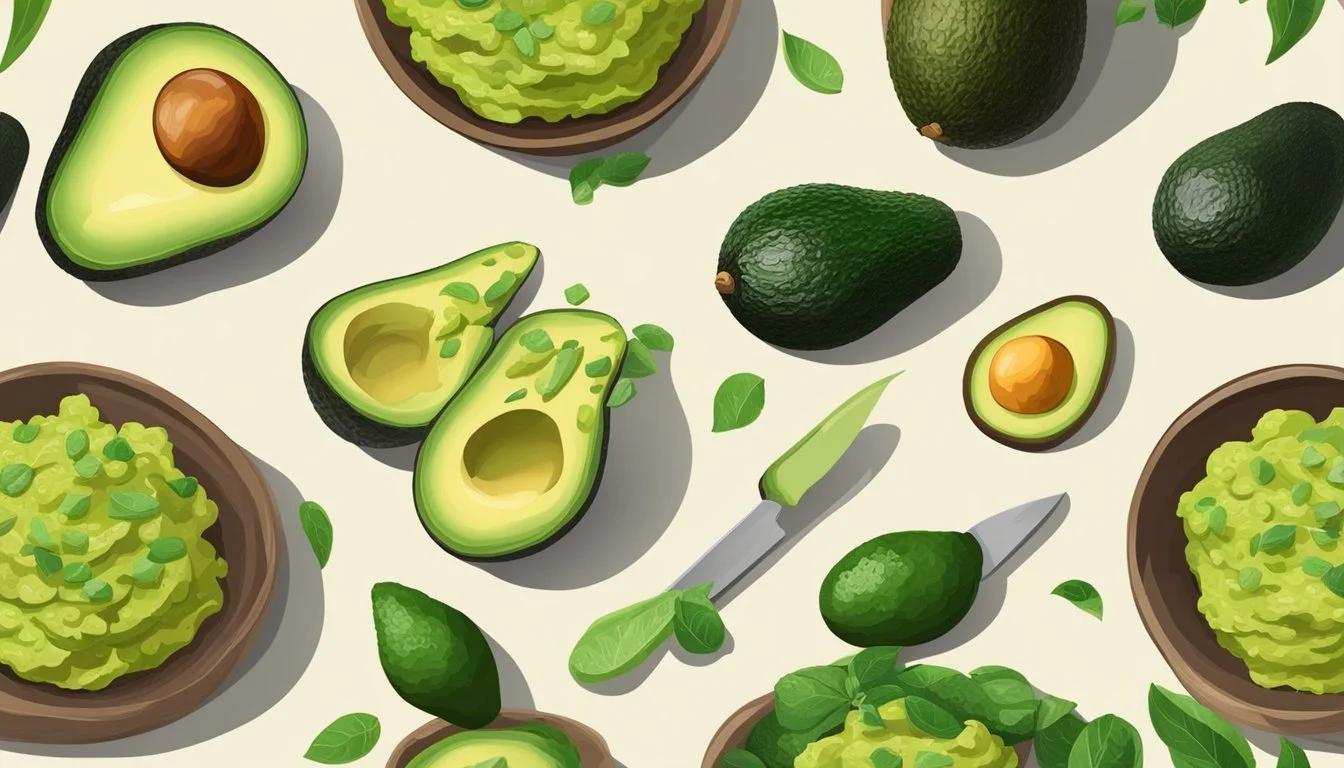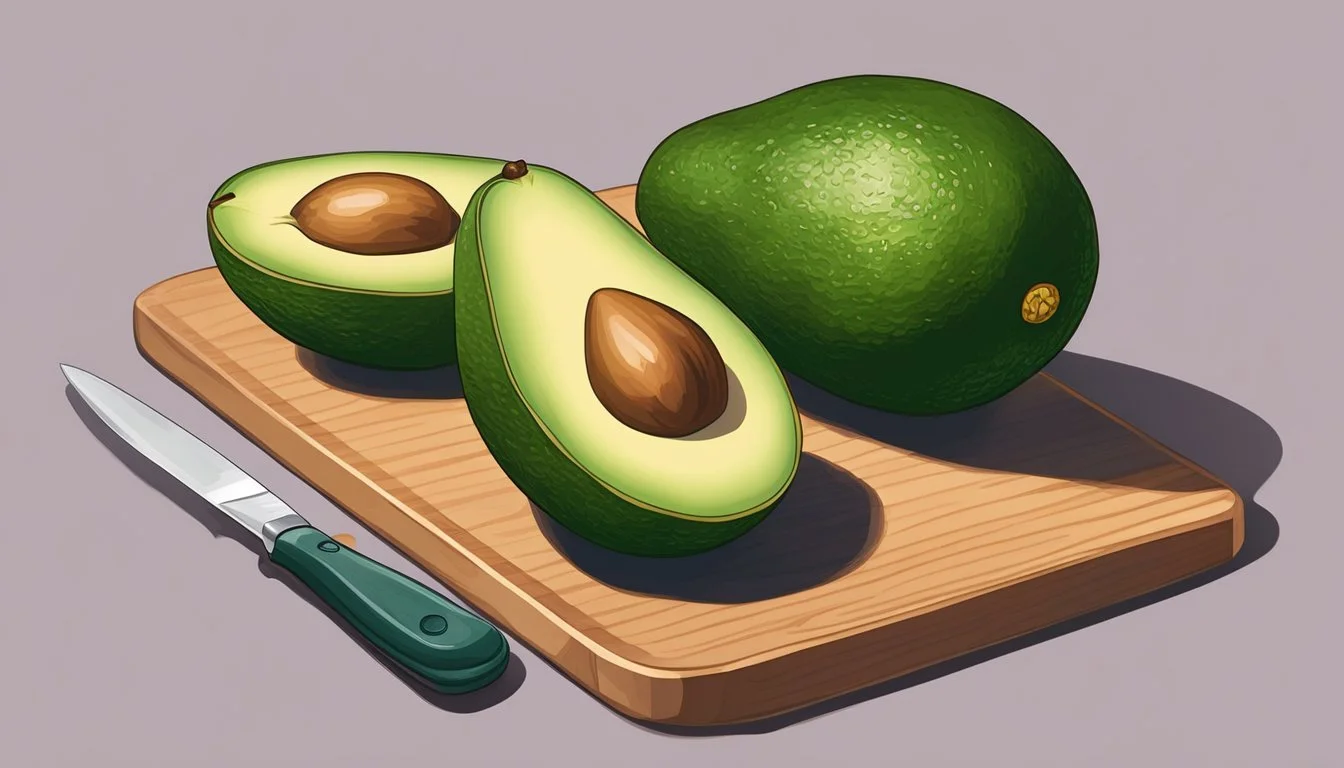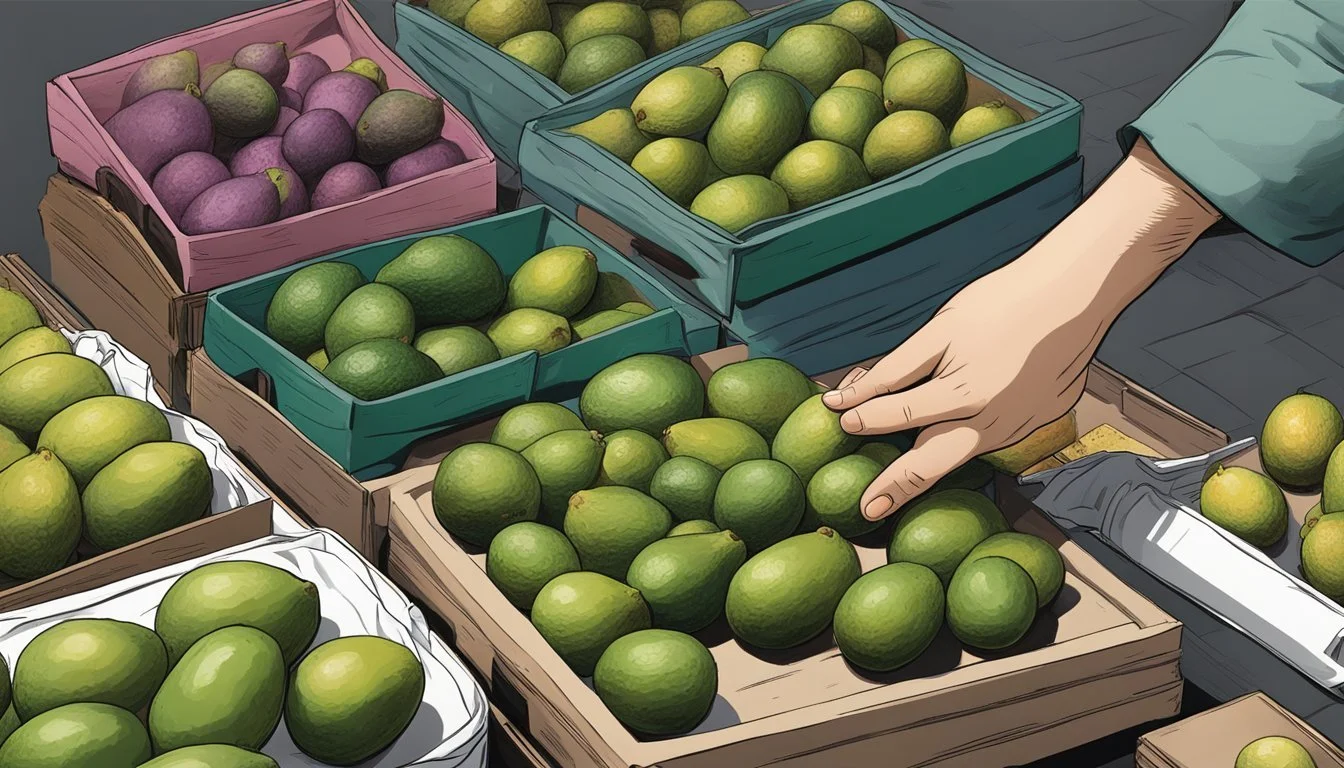How to Tell if Pinkerton Avocados Are Ripe
Your Expert Guide to Perfect Avocados Every Time
Determining the ripeness of Pinkerton avocados is key to enjoying their rich, buttery flavor to the fullest. Recognizable by their elongated pear shape, Pinkerton avocados are a medium-sized variety prized for its creamy texture and high oil content. Unlike some other avocado varieties, the Pinkerton's skin remains green when ripe, making it slightly more challenging to assess its ripeness through color alone.
To ensure you get the best out of your Pinkerton avocados, it's essential to understand how to tell if they're ripe. A ripe Pinkerton avocado will yield to gentle pressure when cradled in the palm of your hand. The skin should be bumpy but not overly soft, and there should be no deep indentations or uneven soft spots. Remember that the window for peak ripeness is narrow, so it is important to check avocados frequently and use them at their prime. Storing avocados at room temperature is optimal until they reach ripeness, and then they can be refrigerated to slow further ripening.
Key Takeaways
A ripe Pinkerton avocado yields to gentle pressure and has a bumpy, green skin.
Peak ripeness of avocados offers the best flavor and texture, requiring frequent checking.
Store Pinkerton avocados at room temperature until ripe, then refrigerate to maintain freshness.
Identifying Pinkerton Avocados
In order to differentiate Pinkerton avocados from other varieties, one should pay close attention to their distinctive physical characteristics and compare them to the commonly known Hass avocados.
Unique Characteristics of Pinkerton Avocados
Pinkerton avocados are distinguished by their elongated pear shape and medium size. They possess green, lightly pebbled skin which is tough but not overly thick, safeguarding the creamy flesh inside. The skin's texture is bumpy, resembling pebbles. When ripe, their skin maintains its green color, differentiating them from some other varieties that darken.
Comparing Pinkerton and Hass Avocados
Although both Pinkerton and Hass avocados exhibit a green skin when unripe, Hass avocados tend to darken as they ripen, which is not the case with Pinkerton avocados. The shape is a notable distinction; Hass avocados are rounder, while Pinkerton avocados are more elongated. When it comes to size, Pinkerton fruits are usually larger than the Hass variety. In terms of texture, both have high oil content which makes them similarly creamy. However, the skin of the Pinkerton is a bit thinner and their bumps sharper compared to the slightly thicker, pebbly skin of the Hass.
Determining Ripeness
When selecting Pinkerton avocados, accurate assessment of ripeness is crucial for the best taste and texture. The following subsections provide specific methods for evaluating the ripeness of Pinkerton avocados.
Assessing Skin Color and Texture
Ripe Pinkerton avocados showcase a shift from bright green to darker hues. The skin color of a mature avocado typically ranges from dark green to almost black. Its texture should be notably bumpy and slightly yielding to touch, though not soft enough to indicate overripeness.
Feeling for Ripeness by Pressure
Applying gentle pressure is a trusted method to test for ripeness. When lightly squeezed, the flesh of ripe avocados should be soft but not mushy. If the avocado feels hard and does not give under pressure, it is likely unripe. Conversely, if it feels too squishy, it may be overripe.
The Stem Test
Carefully remove the small stem or cap at the top of the Pinkerton avocado. If the underlying area is a yellow-green color, the fruit is generally ripe. If the area is brown, the avocado might be overripe. An unripe avocado often has a stem that’s difficult to remove.
Additional Ripeness Indicators
Beyond touch and sight, ripe avocados may exhibit a slight give near the top of the fruit where the stem was attached. Additionally, the flesh inside should be a vibrant yellow-green when ripe. If the flesh appears brown or smells off, the avocado is likely overripe.
Storing and Handling Avocados
When it comes to Pinkerton avocados, proper storage and handling are crucial to maintain their quality. This section will explore how to create the optimal conditions for storing avocados, methods to prevent them from over-ripening, and techniques to keep them fresh after they've been sliced.
Optimal Storage Conditions
Pinkerton avocados should be stored at room temperature until they are ripe. Unripe avocados ripen best when kept out of direct sunlight in a cool place, between 60-75°F. Once ripe, avocados can be moved to the refrigerator to slow down further ripening. The colder temperature of the refrigerator, ideally set at 40°F, helps to preserve the fruit's texture and flavor.
Preventing Over-Ripening
To avoid over-ripening, one can remove ripe avocados from sources of ethylene gas, a natural ripening agent that fruits produce. Storing them separately from bananas, tomatoes, and apples, which emit higher levels of ethylene, is advisable. Placing ripe avocados in the refrigerator also decelerates their ripening process.
Extending Freshness After Slicing
To maintain the freshness of a sliced avocado, minimize its exposure to air. Applying lime juice or lemon juice on the cut areas can prevent browning due to oxidation. Wrap the avocado tightly in plastic wrap or store the sliced pieces in an airtight container before placing them in the refrigerator. For longer-term storage, pureed avocado can be frozen.
Culinary Uses for Pinkerton Avocados
Pinkerton avocados are prized for their creamy texture and nutty flavor, making them ideal for a wide range of dishes, from traditional recipes to more innovative culinary creations. This section explores the various ways one can utilize Pinkerton avocados in the kitchen.
Classic and Innovative Recipes
Pinkerton avocados shine in classic recipes like guacamole and avocado toast. However, their versatility extends to innovative dishes as well. For example:
Guacamole: Their small seed and creamy texture make them easy to mash, enhancing guacamole's rich flavor.
Salads: Sliced Pinkerton avocados add a buttery note to salads.
Sandwiches: They can be sliced or mashed to add a smooth, rich layer in sandwiches.
Smoothies: Their creamy flesh contributes to a luxurious smoothie consistency.
Preparation Techniques for Pinkerton Avocados
Pinkerton avocados are relatively easy to work with due to their texture and the ease of peeling. Here are a few techniques:
Slicing: They can be easily sliced without much mess, perfect for salads and sandwiches.
Dicing and Mashing: The flesh dices cleanly, and it mashes smoothly, ideal for dips and spreads.
Pairing Flavors with Pinkerton Avocados
The nutty flavor of Pinkerton avocados pairs well with a variety of ingredients. Here are some ideal flavor combinations:
Citrus: Lime or lemon juice not only prevents browning but also accentuates the avocado's flavor.
Spices: Chili, cumin, and coriander complement its richness.
Herbs: Cilantro and basil can bring freshness to avocado-based dishes.
Using Pinkerton avocados in culinary applications can enhance the flavor profile and add a rich, creamy texture to an array of dishes.
Nutritional Profile and Health Benefits
Pinkerton avocados are revered not only for their taste but also for their impressive nutritional content, which contributes significantly to overall health.
Vitamins and Minerals in Pinkerton Avocados
Pinkerton avocados are a treasure trove of essential vitamins and minerals. A serving provides a notable amount of vitamin C, which is important for immune function, and vitamin K, critical for blood clotting and bone health. They also contain B vitamins such as B6 and pantothenic acid, which are essential for energy metabolism, and folate, which is crucial for cell division and DNA synthesis.
Vitamin C: Important for immune function
Vitamin K: Aids in blood clotting and bone health
Vitamin B6 & Pantothenic Acid: Support energy metabolism
Folate: Essential for DNA synthesis and cell division
Healthy Fats and Heart Health
The heart health benefits of Pinkerton avocados are substantial due to their monounsaturated and polyunsaturated fats. These fats can help maintain healthy cholesterol levels and subsequently may lower the risk of heart disease when they replace saturated fats in the diet. The presence of potassium can also contribute to controlling blood pressure, offering a two-pronged approach to cardiac care.
Monounsaturated Fats: May improve cholesterol levels
Potassium: Helps control blood pressure
Dietary Fiber and Digestion
Each Pinkerton avocado includes a good amount of dietary fiber, which is vital for maintaining a healthy digestive system. Fiber helps to regulate the digestive process, reducing the likelihood of constipation and may play a role in maintaining a healthy gut microbiome. Furthermore, adequate fiber intake is associated with a host of health benefits, including potential regulation of blood sugar levels.
Dietary Fiber: Promotes digestion and may regulate blood sugar
Growing Pinkerton Avocados
Successfully cultivating Pinkerton avocados hinges upon understanding the variety's specific growing conditions and care requirements. This section demystifies the subtleties of climate, soil, watering, fertilization, and harvesting methods appropriate for Pinkerton avocados.
Climate and Soil Requirements
Pinkerton avocados thrive in climates where temperatures remain above freezing, as cold weather can damage the trees. These avocados are ideally grown in regions with a moderate climate, such as Ventura County, which is known for its abundant avocado orchards. They require well-draining soil to prevent root rot and other moisture-related diseases. Soils rich in organic content with a pH between 6 to 6.5 are optimal.
Climate:
Minimum Temperature: Above freezing
Optimal Regions: Moderate climates, e.g., Ventura County
Soil:
Type: Well-draining, rich in organic content
pH Level: 6.0 - 6.5
Watering and Fertilization Techniques
Watering should be regular and appropriate to the soil's capacity to absorb moisture without becoming water-logged. Pinkerton avocados benefit from deep watering, allowing the soil to dry out between sessions. Fertilization is important for the health and productivity of these trees. A balanced fertilizer should be applied regularly, in accordance with the growth stage of the tree and the nutrients already present in the soil.
Watering:
Deep watering sessions
Allow soil to dry out between watering
Fertilization:
Use a balanced fertilizer
Apply as per the tree's growth stage and soil nutrient levels
Harvesting Times and Methods
Pinkerton avocados are typically ready for harvest in early fall, though the exact timing can vary based on local climate conditions. Farmers assess ripeness by examining the fruit's size and feel. Upon harvesting, the avocados continue to ripen, developing their rich creamy texture and flavor. It's crucial to use proper techniques to minimize damage to the fruit during the harvest process.
Harvesting:
Time: Early fall (may vary with climate)
Method: Assess size and feel; avoid damaging the fruit during harvest
Selecting Avocados at the Market
When venturing to the farmers’ markets to find ripe Pinkerton avocados, knowing what to look for is key. Pinkerton avocados are distinguished by their elongated pear shape. Here's a quick guide:
Size and Shape:
Pinkerton avocados are medium-sized.
They should have an elongated pear shape.
Visual Inspection:
The skin color should be a consistent medium to dark green.
Avoid avocados with uneven coloring, extreme dark spots, or excessive blemishes. These may indicate overripe or damaged fruit.
Skin Texture:
Ripe Pinkertons will have a lightly pebbled texture.
The skin should be tough but not overly hard.
Firmness Test:
Gently squeeze the avocado without applying too much pressure.
A ripe avocado will yield slightly, feeling firm but not mushy.
Be cautious of any avocados with soft spots or bruising.
Firmness: Hard
Indication: Unripe
Firmness: Slight Yield
Indication: Ripe, Ready to Eat
Firmness: Very Soft
Indication: Overripe, Possible Spoilage
Stem Check:
Inspect the stem or cap at the top of the Pinkerton avocado.
Peel back the small stem; a green area underneath suggests a good ripe state.
A brown area under the stem indicates the avocado is likely overripe.
Choosing ripe Pinkerton avocados at the market requires a careful combination of visual cues and tactile feedback. Their size, skin texture, firmness, and the condition of the stem area are reliable indicators of ripeness. Remember, a ripe Pinkerton should feel creamy on the inside and exhibit a green area under the stem. With these guidelines, selecting avocados at farmers’ markets becomes a straightforward task.
Troubleshooting Common Issues
When it comes to Pinkerton avocados, certain challenges may arise, such as bruising, spoilage, and diseases. Knowing how to prevent and identify these issues is crucial for ensuring fruit quality.
Preventing and Identifying Bruising
A common concern with Pinkerton avocados is bruising. This can occur due to rough handling or pressure placed on the fruit during transportation or storage. To prevent bruising:
Handle avocados gently, especially when transporting or storing them.
Check for bruises by looking for soft spots or indentations.
If bruising is present, the fruit will feel mushy, and discoloration might be visible when the avocado is cut open.
Avoiding Mishandling and Spoilage
Mishandling can lead to spoilage and a poor eating experience. Here's how to avoid it:
Do not squeeze avocados excessively when checking for ripeness.
Store properly: Keep unripe avocados at room temperature and ripe ones in the refrigerator.
An overripe avocado might appear overly soft and have a darker, almost black skin. Inside, brown, mushy flesh or an off odor indicates spoilage.
Dealing with Pests and Diseases
Pests and diseases can affect the integrity of Pinkerton avocados. Regular monitoring is key for early detection and management of such issues. Look out for:
Blemishes on the skin that may indicate the presence of pests or disease.
Signs of infection, like spots or rot, which may necessitate the removal of the affected avocados to prevent spread.
Using proper cultivation and sanitation techniques reduces the risk of pest infestations and disease outbreaks.





